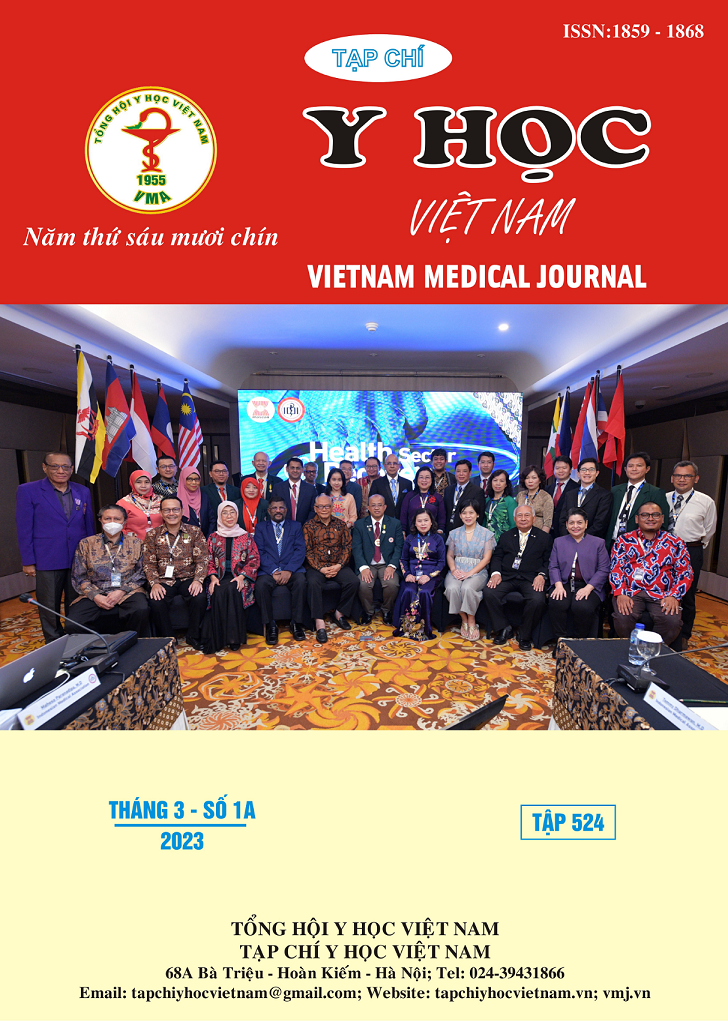REVIEWS PROGESTERONE LEVELS WITH CLINICAL PREGNANCY RATES IN FROZEN EMBRYO TRANSFER
Main Article Content
Abstract
Objectives: To review progesterone levels prior to embryo transfer with clinical pregnancy rates in day 5 frozen embryo transfer at Hai Phong Maternity Hospital. Research methods: retrospective description. Results: The clinical pregnancy rate in the study was 72.4%. The mean serum progesterone (P4) levels prior to embryo transfer in the study group were 11.22 ± 3.98ng/mL. The ROC curve showed a significant predictive value of pre-embryonic serum P4 concentrations for clinical pregnancy rates, a high value area under the curve (AUC) of 0.6628. The optimal threshold value for predicting P-level clinical pregnancy is 9.2 ng/ml (sensitivity 77.53%, specificity 54.74%). The group of patients with Progesterone >9.2ng/ml was 2.62 times more likely to have a clinical pregnancy than the other group (95%CI = 1.17 – 5.86) statistically significant with p = 0.017.There was an inverse association between progesterone levels before 1-day embryo transfer and weight, with correlation coefficients p = 0.043 and r = - 0.1288. There were no significant differences in the concentration of age-related serum progesterone, uterine mucosa, BMI. Conclude: The clinical pregnancy rate in the sero-P4 group >9.2 ng/ml (76.4%) was statistically significant compared to the P4 group ≤ 9.2 ng/ml (55.3%) with p = 0.017. More research is needed to determine when to measure progesterone levels and find the right cut-off point for each assisted reproductive center. An individualized strategy for corpus luteal support in frozen embryo transfer and progesterone supplementation regimens should be introduced in cases with a low P4 equal to subcutaneous, intramuscular P4.
Article Details
Keywords
frozen embryo transfer, clinical pregnancy rate, Progesterone before embryo transfer
References
2. Labarta E, Rodríguez C. Progesterone use in assisted reproductive technology. Best Pract Res Clin Obstet Gynaecol. 2020;69:74-84.
3. Cédrin-Durnerin I, Isnard T, Mahdjoub S, et al. Serum progesterone concentration and live birth rate in frozen-thawed embryo transfers with hormonally prepared endometrium. Reprod Biomed Online. 2019;38(3):472-480.
4. Labarta E, Mariani G, Holtmann N, Celada P, Remohí J, Bosch E. Low serum progesterone on the day of embryo transfer is associated with a diminished ongoing pregnancy rate in oocyte donation cycles after artificial endometrial preparation: a prospective study. Hum Reprod. 2017;32(12):2437-2442.
5. Gaggiotti-Marre S, Martinez F, Coll L, et al. Low serum progesterone the day prior to frozen embryo transfer of euploid embryos is associated with significant reduction in live birth rates. Gynecol Endocrinol. 2019;35(5):439-442.
6. Boynukalin FK, Gultomruk M, Turgut E, et al. Measuring the serum progesterone level on the day of transfer can be an additional tool to maximize ongoing pregnancies in single euploid frozen blastocyst transfers. Reprod Biol Endocrinol. 2019;17(1):102.
7. Nguyễn Minh Phương, Đoàn Thị Hằng, Thành, et al. Khảo sát nồng độ Progesterone huyết thanh trước chuyển phôi và mối liên quan với một số đặc điểm lâm sàng ở chu kỳ chuyển phôi đông lạnh. VietNam Mil Med Unisversity. 2022;47(7):30-38.
8. González-Foruria I, Gaggiotti-Marre S, Álvarez M, et al. Factors associated with serum progesterone concentrations the day before cryopreserved embryo transfer in artificial cycles. Reprod Biomed Online. 2020;40(6):797-804.
9. Yarali H, Polat M, Mumusoglu S, et al. Subcutaneous luteal phase progesterone rescue rectifies ongoing pregnancy rates in hormone replacement therapy vitrified–warmed blastocyst transfer cycles. Reprod Biomed Online. 2021;43(1):45-51.


